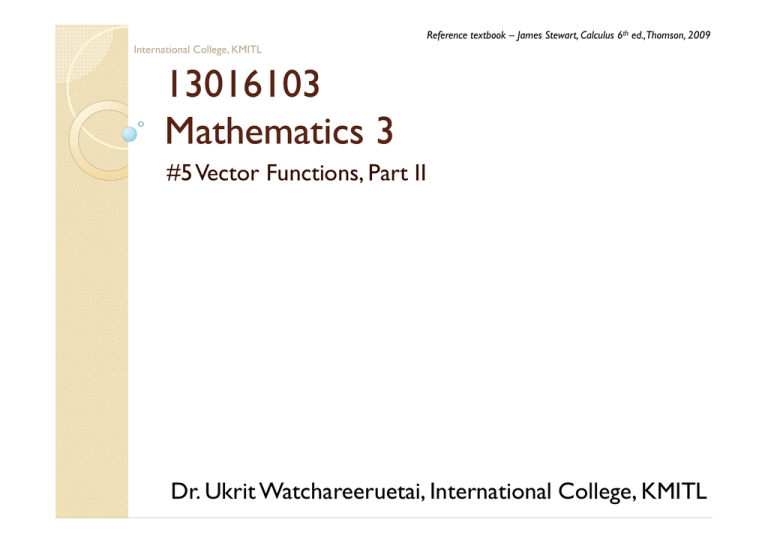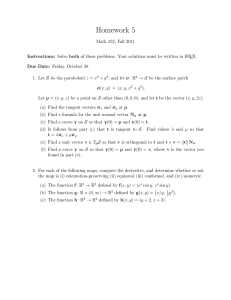Vector Functions, Part II File
advertisement

Reference textbook – James Stewart, Calculus 6th ed.,Thomson, 2009 International College, KMITL 13016103 Mathematics 3 #5 Vector Functions, Part II Dr. Ukrit Watchareeruetai, International College, KMITL International College, KMITL Content of this lecture Derivatives and integrals of vector functions Arc length and curvature Motion in space: velocity and acceleration Reference textbook – James Stewart, Calculus 6th ed., Thomson, 2009 Vector Functions 2 International College, KMITL DERIVATIVES AND INTEGRALS OF VECTOR FUNCTIONS Vector Functions 3 International College, KMITL Derivatives The derivative r' of a vector function r is defined in the same way as for real-valued functions: if this limit exists. Vector Functions 4 International College, KMITL Derivatives The geometric significant is shown in the figure. The points P and Q have position vector r(t) and r(t+h). The vector from P to Q is represented by r(t+h) – r(t), regarded as a secant vector. Vector Functions 5 International College, KMITL Derivatives If h > 0, the vector (1/h)(r(t+h) – r(t)) will have the same direction as r(t+h) – r(t). As h →0, this vector approaches a vector that lies on the tangent line. So the vector r'(t) is called the tangent vector. And the unit tangent vector is Vector Functions 6 International College, KMITL Derivatives The following theorem gives us a convenient method for computing the derivative of a vector function r: Vector Functions 7 International College, KMITL Derivatives Vector Functions 8 International College, KMITL Example 1 Find the derivative of r(t) = (1+t3)i + te-1j + sin(2t) k. Find the unit tangent vector at the point where t = 0. Vector Functions 9 International College, KMITL Example 2 For the curve r(t) = t1/2i + (2 - t)j, find r'(t) and sketch the position vector r(1) and the tangent vector r'(1). Vector Functions 10 International College, KMITL Example 3 Find parametric equations for the tangent line to the helix with parametric equations at the point (0, 1, π/2) Vector Functions 11 International College, KMITL Derivative rules Suppose u and v are diffentiable vector functions, c is a scalar and f is a real-valued fucntion. Then Vector Functions 12 International College, KMITL Example 4 Show that if |r(t)| = c (a constant), then r'(t) is orthogonal to r(t) for all t. Vector Functions 13 International College, KMITL Integrals The definite integral of a continuous vector function r(t) can be defined in the same way as for real-valued functions. and so Vector Functions 14 International College, KMITL Integrals We can rewritten the formular as follow: where R(t) is an antiderivative of r, that is, R'(t) = r(t). We use the notation ∫r(t) for indefinite integrals (antiderivatives). Vector Functions 15 International College, KMITL Example 5 If r(t) = 2cos t i + sin t j + 2t k, then find the antiderivative of r(t). Vector Functions 16 International College, KMITL ARC LENGTH AND CURVATURE Vector Functions 17 International College, KMITL Arc length In previous lecture, we have defined the length of a plane curve with parametric equations x= f(t) and y = g(t), a ≤ t ≤ b: Vector Functions 18 International College, KMITL Arc length The length of a space curve is defined in exactly the same way: Vector Functions 19 International College, KMITL Arc length Note that: ◦ The arc length formulars for both plane curves (2D) and space curves (3D) can be put into the more compact form: Vector Functions 20 International College, KMITL Example 1 Find the length of the arc of the circular helix with vector equation r(t) = cos t i + sin t j + t k from the point (1, 0, 0) to the point (1, 0, 2π). Vector Functions 21 International College, KMITL Parameterization A single curve C can be represented by more than one vector function. For example, can also be represented by the function where the connection between the parameters t and u is given by t = eu. We say that these two equations are parameterizations of the curve C. Vector Functions 22 International College, KMITL Arc length function Suppose that C is a curve given by a vector function where r'(t) is continuous and traversed exactly once as t increases from a to b. We define its arc length function s by Vector Functions 23 International College, KMITL Arc length function Thus s(t) is the length of the part of C between r(a) and r(t). Vector Functions 24 International College, KMITL Arc length function If we differentiate both side of the equation we obtain Vector Functions 25 International College, KMITL Parameterize a curve with respect to arc length It is often useful to parameterize a curve with respect to arc length because arc length arises naturally from the shape of the curve and does not depend on a particular coordinate system. If a curve r(t) is already given in terms of a parameter t and s(t) is the arc length function, then we may be able to solve for t as a function of t = t(s). Then the curve can be reparameterized in terms of s by substituting for t: r = r( t(s) ). Vector Functions 26 International College, KMITL Example 2 Reparameterize the helix r(t) = cos t i + sin t j + t k with respect to arc length from (1, 0, 0) in the direction of increasing t. Vector Functions 27 International College, KMITL Curvature A parameterization r(t) is called smooth on an interval I if r' is continuous and r'(t) ≠ 0 on I. A curve is called smooth if it has a smooth parameterization. A smooth curve has no sharp corners or cusps; when the tangent vector turns, it does so continuously. Vector Functions 28 International College, KMITL Curvature If C is a smooth curve defined by the vector function r, recall that the unit tangent vector T(t) is given by and indicates the direction of the curve. Vector Functions 29 International College, KMITL Curvature From the figure, you can see that T(t) changes direction very slowly when C is fairly straight, but it changes direction more quickly when C bends or twists more sharply. The curvature of C at a given point is a measure of how quickly the curve changes direction at the point. Vector Functions 30 International College, KMITL Curvature Specifically, we define the curvature to be the magnitude of the rate of change of the unit tangent vector with respect to arc length. ◦ Note: we use arc length so that the curvature will be independent of the parameterization Vector Functions 31 International College, KMITL Curvature We can use the Chain rule to write so Vector Functions 32 International College, KMITL Curvature Vector Functions 33 International College, KMITL Curvature Vector Functions 34 International College, KMITL Example 3 Show that the curvature of a circle of radius a is 1/a. Vector Functions 35 International College, KMITL Example 4 Find the curvature of the twisted cubic r(t) = <t, t2, t3> at a general point and at (0, 0, 0). Vector Functions 36 International College, KMITL Example 5 Find the curvature of the parabola y = x2 at the points (0, 0), (1, 1) and (2, 4). Vector Functions 37 International College, KMITL The normal and binormal vectors At a given point on a smooth space curve r(t), there are many vectors that are orthogonal to the unit tangent vector T(t). Because T'(t)·T(t) = 0, so T'(t) is orthogonal to T(t). ◦ Note that T'(t) itself is not a unit vector. Vector Functions 38 International College, KMITL The normal and binormal vectors If r' is also smooth, we can define the principle unit normal vector N(t) (or simply unit normal) as Vector Functions 39 International College, KMITL The normal and binormal vectors The vector B(t) = T(t) × N(t) is called the binormal vector. It is perpendicular to both T and N and is also a unit vector. Vector Functions 40 International College, KMITL The normal and binormal vectors The plane determined by N and B at a point P on a curve C is called the normal plane of C at P. This plane consists of all lines that are orthogonal to the tangent vector T. Vector Functions 41 International College, KMITL Example 6 Find the unit normal and binormal vectors for the circular helix r(t) = cos t i + sin t j + t k Vector Functions 42 International College, KMITL Example 7 Find the equations of the normal plane of the helix in Example 6 at the point P(0, 1, π/2). Vector Functions 43 International College, KMITL MOTION IN SPACE: VELOCITY AND ACCELERATION Vector Functions 44 International College, KMITL Velocity and acceleration In this section, we show how the ideas of tangent and normal vectors and curvature can be used in physics to study the motion of an object. Suppose a particle moves through space so that its position vector at time t is r(t). Vector Functions 45 International College, KMITL Velocity and acceleration For small value of h, the vector approximates the direction of the particle moving along the curve r(t). Vector Functions 46 International College, KMITL Velocity and acceleration The magnitude of measures the size of the displacement vector per unit time. The vector gives the average velocity over a time interval of length h and its limit is the velocity vector v(t) at time t. Thus the velocity vector is the tangent vector. Vector Functions 47 International College, KMITL Velocity and acceleration The speed of the particle at time t is the magnitude of the velocity vector. So the speed is the rate of change of distance with respect to time. The acceleration of the particle is defined as the derivative of the velocity: Vector Functions 48 International College, KMITL Example 1 The position vector of an object moving in a plane is give by r(t) = t3i + t2j. Find its velocity, speed, and acceleration when t = 1 and sketch them. Vector Functions 49 International College, KMITL Example 2 Find the velocity, acceleration, and speed of a particle with position vector r(t) = <t2, et, tet>. Vector Functions 50 International College, KMITL Example 3 A moving particle starts at an initial point r(0) = <1, 0, 0> with initial velocity v(0) = i – j + k. Its acceleration is a(t) = 4ti + 6tj + k. Find its velocity and position at time t. Vector Functions 51 International College, KMITL Example 4 An object with mass m that moves in a circular path with constant angular speed ω has position vector r(t) = a cos ωt i+ a sin ωt j. Find the force acting on the object and show that it is directed toward the origin. Vector Functions 52


